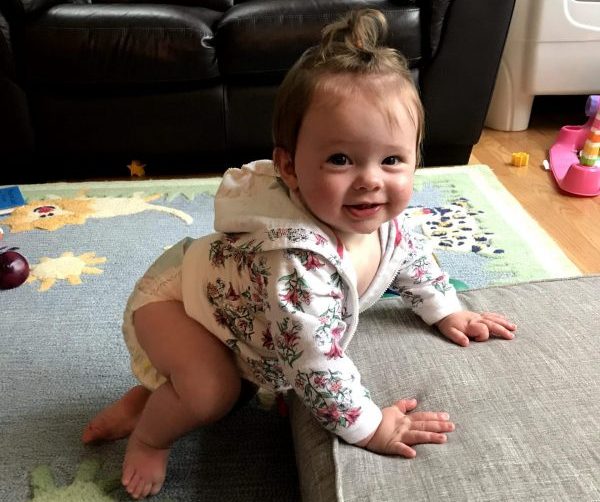 When you become a mom, you start carrying around a whole list of fears and worries. Some totally unfounded. Others very real possibilities. One of my fears, from the moment I learned I was pregnant, was that my child would fall behind on her developmental milestones. It wasn’t because I feared having a child who was delayed. It was because I feared having to figure out how to get her the right resources. It’s safe to say most new moms know nothing about early intervention until their child needs it.
When you become a mom, you start carrying around a whole list of fears and worries. Some totally unfounded. Others very real possibilities. One of my fears, from the moment I learned I was pregnant, was that my child would fall behind on her developmental milestones. It wasn’t because I feared having a child who was delayed. It was because I feared having to figure out how to get her the right resources. It’s safe to say most new moms know nothing about early intervention until their child needs it.
Once my daughter was born, I paid close attention to what other babies her age were doing. At every stage, I would monitor whether she seemed to be developing similarly to the other babies I knew. I quickly recognized that there is a range in all types of development. Different babies develop different skills at different times, so some variation in development seemed normal.
First Steps to Early Intervention
When my daughter was about 8 months old, she could sit up, but couldn’t get to sitting on her own. She was nowhere near crawling. It was about a month after the pandemic had started, so the opportunity to see what other babies were up to was minimal. I completed a child development survey offered through my mom group, and the results suggested she might benefit from further evaluation. At first, I hoped I had skewed the results by answering questions more conservatively than I should have. I checked in with a few other moms who I knew also completed the survey, hoping their kids’ results were similar, thereby normalizing my daughter’s results. No such luck. With encouragement from the survey administrator, I decided I should schedule an evaluation.
Now I had to figure out how to get her the help she needed – during a pandemic. I remember tossing and turning in bed, worrying about how to navigate the process. The next morning, I looked up the number for Early Intervention and gave them a call.
I spoke with a woman who scheduled an intake appointment by phone and an evaluation with two therapists that would take place by video conference. Both were scheduled for the following week. On the intake phone call, I was asked a series of questions about my daughter and her development. Based on my concerns, it was recommended that we move forward with the evaluation.
Virtual Evaluation
Since the evaluation was virtual, the therapists asked me to position my daughter in certain ways to see what she could do. They had her sit and reach for objects and for eating to assess her ability to grasp foods and feed herself. They had her lay on her back and her belly to see whether she could roll.
The therapists were very personable and explained what they were looking for in each position they assessed. There was a handful of things they couldn’t sufficiently assess over video, so they just asked me to describe how I felt my daughter behaved in those situations. After they had collected all of the information they needed, they excused my daughter and me for a diaper change while they discussed the evaluation. When we returned, they told us that she had qualified and a therapist would be in contact within a few weeks to schedule our first session.
Getting Started with Physical Therapy
Two weeks later, I got an email from a physical therapist asking to schedule our first appointment for the following week. I was a little surprised how easy the scheduling was. The PT asked me what time my daughter typically naps and we scheduled the appointment around that. It makes sense to ensure she is in good spirits to get the most out of the appointment. I expected that to be my responsibility to time her naps accordingly, not the other way around. She said the frequency of the sessions was up to me, but her recommendation would be weekly. A lot can change in a week at her age, and I agreed.
After the first session, I was a little skeptical of the list of things we were given to work on. The tasks seemed too trivial to have an impact, but I did them dutifully. As it turns out, I was wrong. By our next session, my daughter was noticeably closer to crawling than the week before. Week to week, we started to see major improvements in her mobility, and five weeks in, she’s a full-blown crawler.
Virtual Session Basics
The visits are currently virtual. I set up my computer so that the PT can see my daughter on the floor of our living room. The PT starts each session with a short assessment of what we worked on from the week before. She’ll have me position my daughter a certain way, or create a particular situation that she needs to navigate, like a pillow to crawl over or a toy to crawl to. I think it actually helps that the sessions are virtual. It allows the PT to give me feedback on correct positioning, so I’m better prepared for what we work on in between sessions.
I didn’t expect any of this experience to be as easy as it was, which is a wonderful thing to be surprised about. Knowing what I know now, those sleepless nights were all for nothing. This experience has helped me feel empowered to navigate the next situation and I’m feeling good about that.










